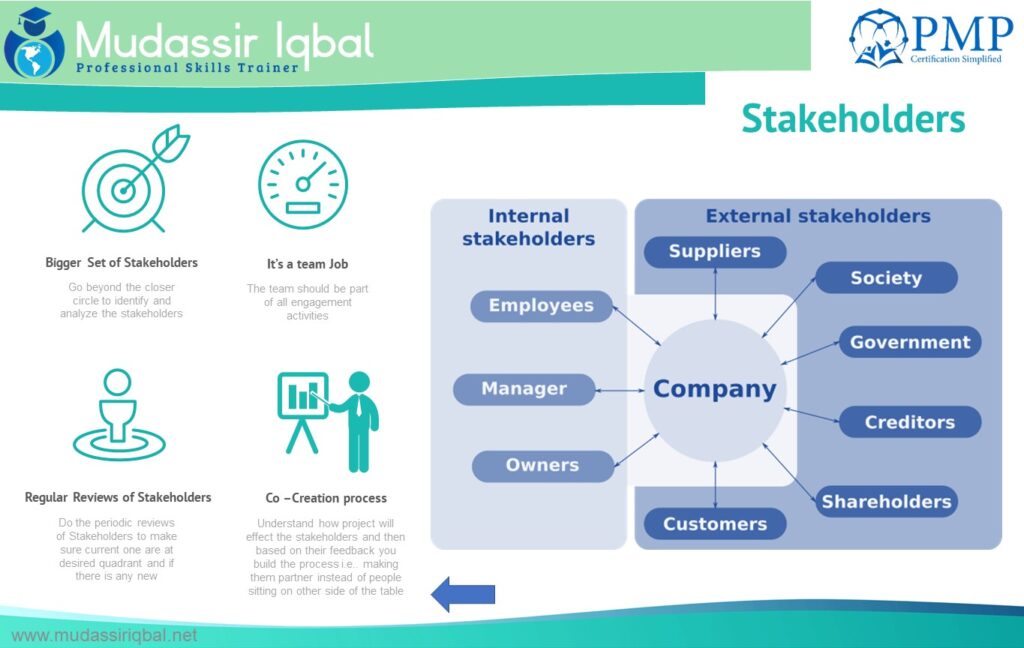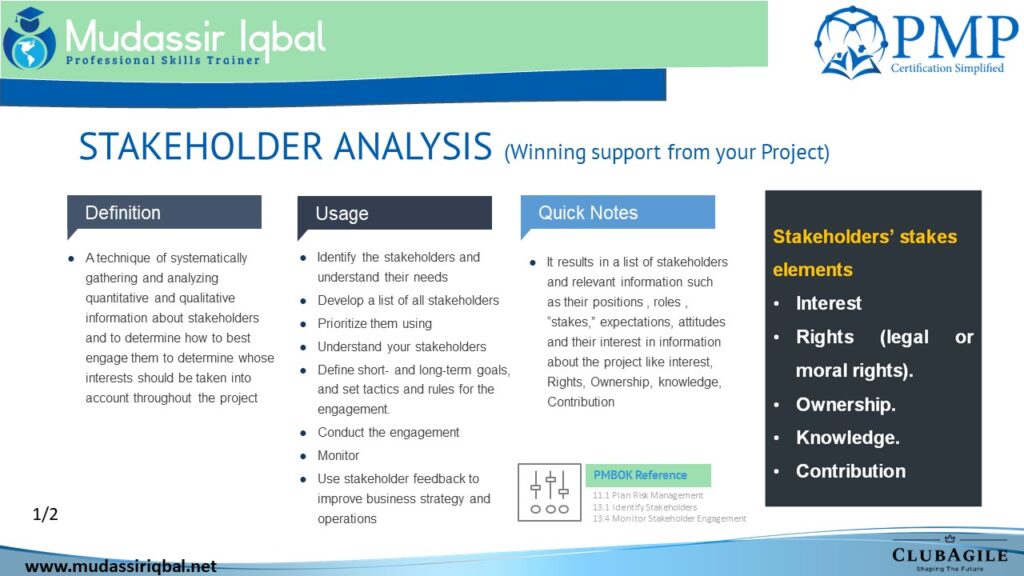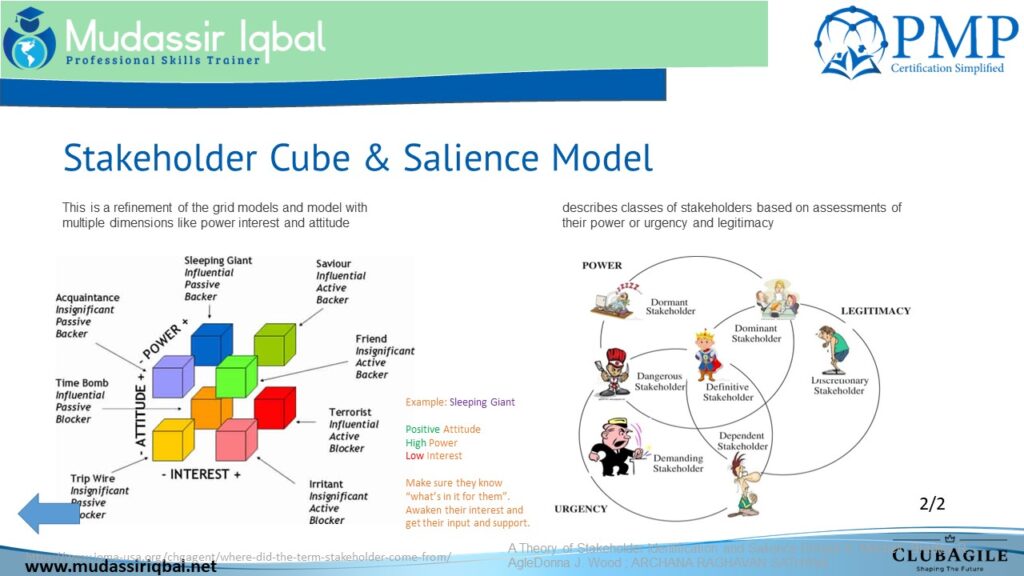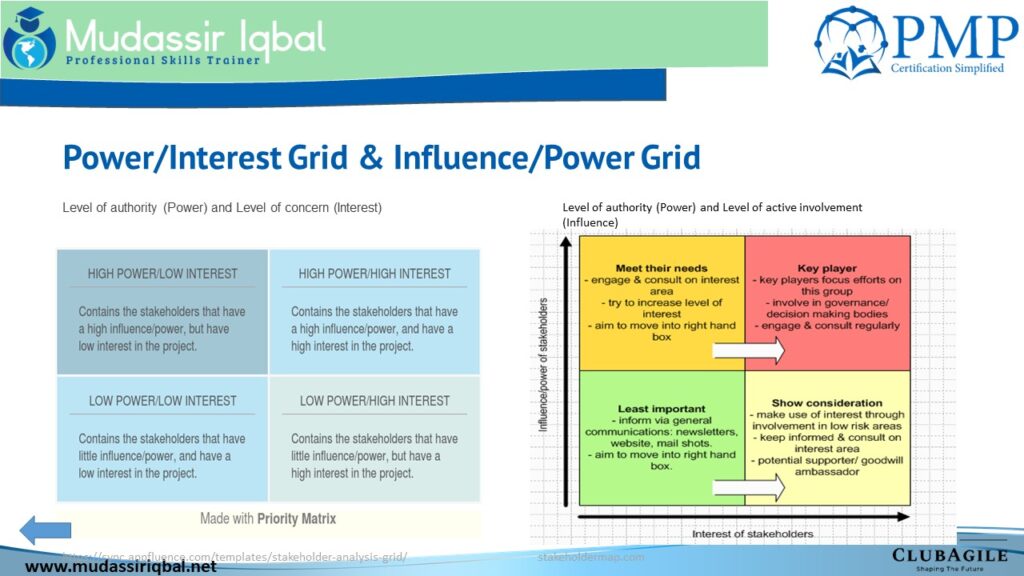Academic research and analyses of high-profile project disasters highlight the importance of a structured approach to the identification, prioritization, and engagement of all stakeholders

To increase the chances of success, the process of stakeholder identification and engagement should commence as soon as possible after the project charter has been approved, the project manager has been assigned and the team begins to form.
- Identify all stakeholders
- Involve all team members in stakeholder engagement
- Review stakeholders along with risks
Who are Stakeholders
Stakeholders are individuals, groups, or organizations that have an interest, impact, or investment in a project or program. They can be internal to an organization or external, and they can influence or be impacted by the project or program.
Examples of stakeholders include:
- Customers or users of the project or program
- Project or program team members
- Sponsors or funding sources
- Regulators or government agencies
- Suppliers or contractors
- Community members
- Non-government organizations (NGOs)
- Competitors
Stakeholders can have varying levels of power, influence, and interest in the project or program, and it is important to understand and manage these relationships in order to ensure the success of the project or program.
Stakeholders Analysis

Stakeholder analysis is a method for identifying, evaluating, and ranking stakeholders in a project, programme, or organisation. The purpose of stakeholder analysis is to understand the requirements, interests, and expectations of stakeholders, and to decide the best method to engage and manage them over the life of the project or programme.

Typically, the process involves identifying stakeholders, analysing their level of influence and interest, and determining their impact on the project or programme. The information acquired during stakeholder analysis is used to construct a stakeholder engagement plan, which specifies how stakeholders will be communicated with and managed throughout the project’s or program’s duration.

Stakeholder Cube
The Stakeholder Cube is a tool used in stakeholder analysis to categorize stakeholders based on their power, interest, and influence. It provides a visual representation of how stakeholders can be grouped based on these factors.
The Stakeholder Cube is typically represented as a cube with three axes: power, interest, and influence. Power refers to a stakeholder’s ability to impact the project or program, interest refers to the stakeholder’s level of involvement and engagement, and influence refers to a stakeholder’s ability to impact the decisions and actions of others.
Stakeholders are positioned on the cube based on their power, interest, and influence, with the most influential and powerful stakeholders located in the center and the less influential and powerful stakeholders located towards the corners.
Salience Model
The Salience Model is a tool used in stakeholder analysis to categorize stakeholders based on their level of power, legitimacy, and urgency. It provides a visual representation of how stakeholders can be grouped based on these factors.
The Salience Model categorizes stakeholders into four categories: high power/high legitimacy, low power/high legitimacy, low power/low legitimacy, and high power/low legitimacy. Power refers to the ability of the stakeholder to impact the project or program, legitimacy refers to the stakeholder’s perceived right to influence the project or program, and urgency refers to the immediate need for attention from the stakeholder.
Stakeholders are positioned in the Salience Model based on their level of power, legitimacy, and urgency, with the most influential and important stakeholders located in the top right quadrant and the least influential and important stakeholders located in the bottom left quadrant.

The Power/Interest Grid and the Influence/Power Grid are two different tools used in stakeholder analysis to categorize stakeholders based on their level of power, interest, and influence.
The grid categorizes stakeholders into four categories: high power/high interest, low power/high interest, low power/low interest, and high power/low interest. Power refers to the ability of the stakeholder to impact the project or program, and interest refers to the stakeholder’s level of involvement and engagement.
- HIGH POWER/LOW INTEREST
Contains the stakeholders that have a high influence/power, but have low interest in the project. - HIGH POWER/HIGH INTEREST
Contains the stakeholders that have a high influence/power, and have a high interest in the project. - LOW POWER/LOW INTEREST
Contains the stakeholders that have little influence/power, and have a low interest in the project. - LOW POWER/HIGH INTEREST
Contains the stakeholders that have little influence/power, but have a high interest in the project.
Stakeholder Perception and its Management
A project’s stakeholder perception refers to how various stakeholders view and comprehend the project’s aims, outcomes, and impact. This perception can significantly effect the success of a project by affecting stakeholder support, cooperation, and participation.
Effective stakeholder perception management on a project entails comprehending the perspectives and expectations of various stakeholders, proactively addressing any issues or misunderstandings, and keeping stakeholders informed and engaged throughout the project lifespan.
To ensure that a project continues on track, fulfils stakeholders’ requirements and expectations, and eventually achieves the required results, it is essential to manage stakeholder perception. To accomplish this, project managers should communicate with stakeholders on a frequent basis, solicit their comments, and change the project as necessary to match with their perceptions.
An overly positive or wrongly positive perception can be a double-edged sword for a project or organization. On one hand, having positive perceptions can build momentum, boost morale, and attract support and resources. On the other hand, overly positive perceptions can lead to unrealistic expectations, blind optimism, and a lack of preparation for potential challenges and risks.
Wrongly positive perceptions can also lead to disappointment and a loss of trust if stakeholders later realize that their initial perceptions were not accurate. This can undermine the success of a project or organization and damage its reputation.
To avoid these outcomes, it is important to manage stakeholder perceptions in a transparent and honest manner, accurately communicating both the strengths and limitations of a project or organization. This helps to set realistic expectations, build trust and credibility with stakeholders, and ultimately ensure the success of the project or organization
Conclusion
In conclusion, understanding and managing stakeholders is a crucial aspect of project and program management. Stakeholder analysis helps to identify, understand, and prioritize the relationships between stakeholders and the project or program, and tools such as the Power/Interest Grid, the Influence/Power Grid, the Stakeholder Cube, or the Salience Model can be used to categorize and prioritize stakeholders. Effective stakeholder engagement and communication can help to ensure that all stakeholders are considered and engaged in a way that maximizes the chances of success for the project or program.


3 thoughts to “Stakeholders”
Pingback: Project Performance Domains - Mudassir Iqbal
Pingback: Agile Terminologies - Mudassir Iqbal
Pingback: Unlocking Success: Mastering the Essential Process Flows of Project Management (PMP/CAPM) - Mudassir Iqbal